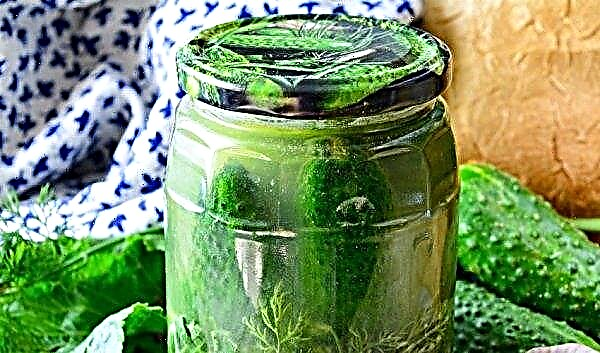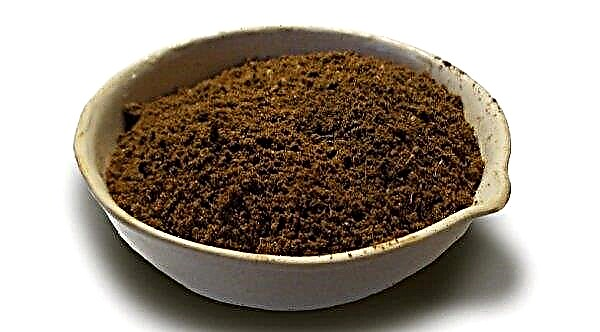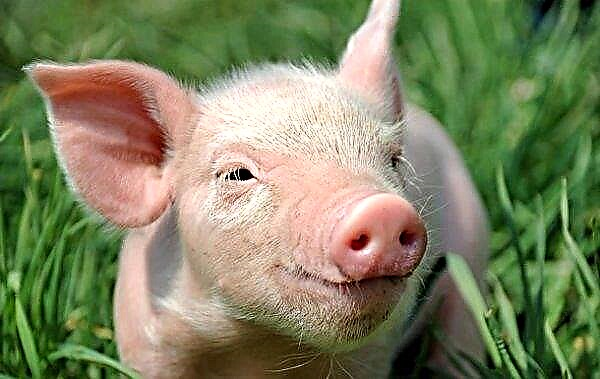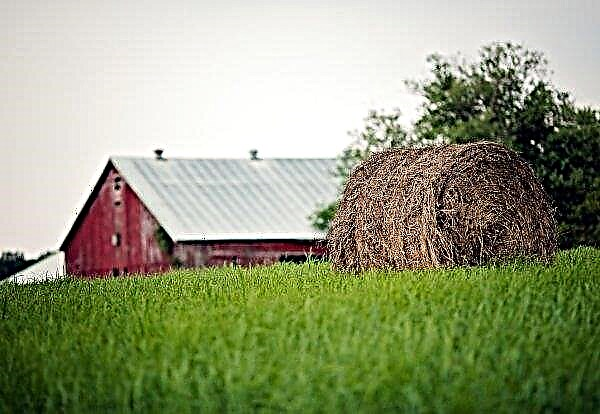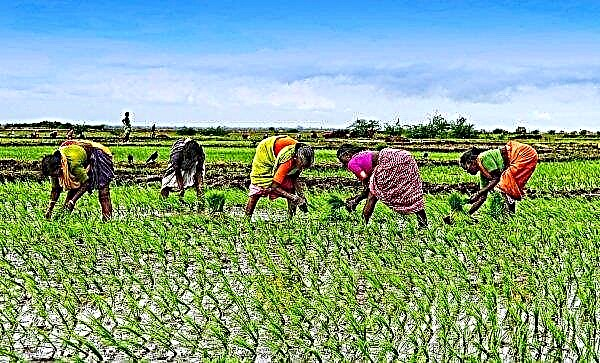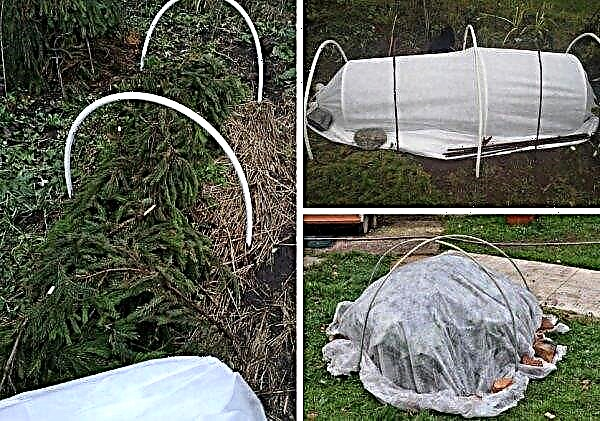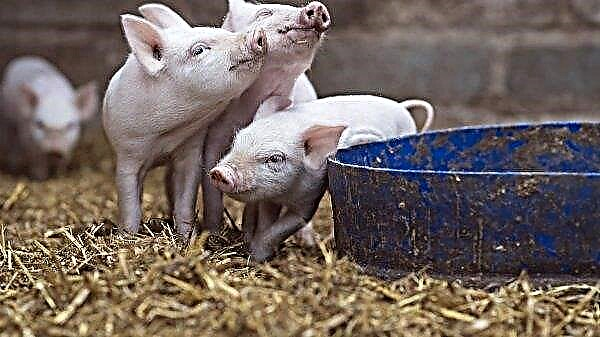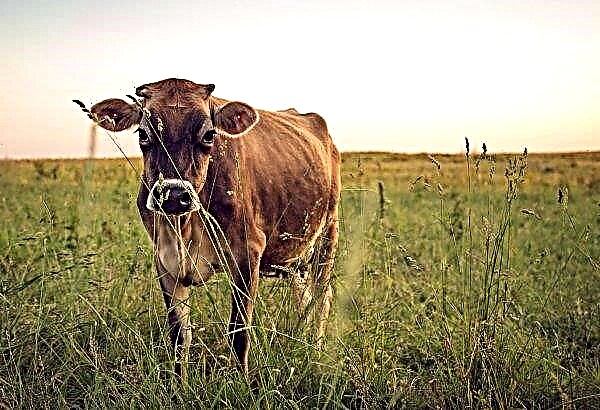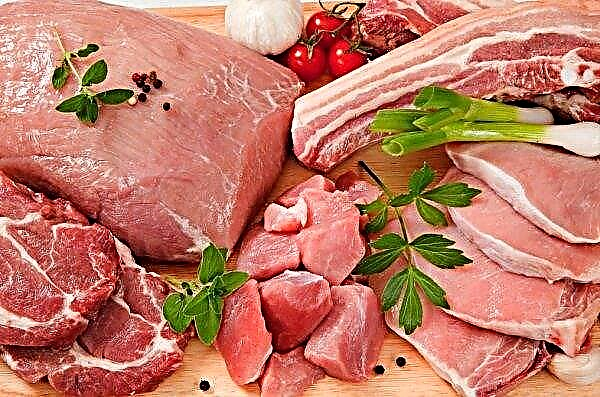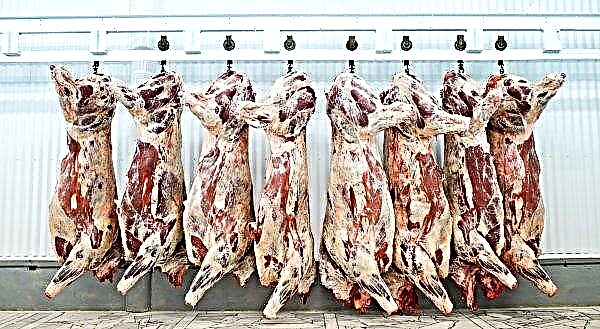Large-fruited varieties of tomatoes are often consumed fresh or processed for preservation, so it is not surprising that many summer residents are interested in the question of their cultivation in a greenhouse. We offer you to get acquainted with the characteristics of the best varieties for film and polycarbonate shelters, the technology and subtleties of their cultivation and harvesting.
The best large varieties
Today there are many varietal variations of tomatoes that can be cultivated in any type of soil, but as for greenhouses (including polycarbonate), more often summer residents choose the following large-fruited varieties of tomatoes.
Did you know? In Europe, XV-XVI century tomatoes were grown only as ornamental plants for gardens, as mentioned in Dutch books. The food began to be consumed only after several centuries.
Altai yellow
A variety of medium early ripening, with large, flat-round yellow fruits. The peel of medium thickness hides a juicy pulp underneath, with a subtle sour taste. Tomato bushes grow up to 2 m in height, and from the appearance of the first sprouts to the time of harvesting the tomatoes takes at least 4 months.

Bull heart red
The variety belongs to medium-late varieties of tomato, since from the moment of planting to harvesting it takes at least 120-125 days. It can be planted both in a greenhouse and in an unprotected substrate, where the plant reaches a 2-meter height. The fruits in the shape of a heart are large, with an average density of pulp and a weight of 200-400 g, although some specimens can grow 600 g. The taste of fleshy pulp is pronounced, with acidity. In open areas, up to 5 kg of crop is harvested from 1 m², and up to 12 kg of ripe tomatoes are obtained from the same area in a greenhouse.

Giant-10 Novikov
One of the famous varieties, bearing large fruits, for greenhouses. The plant bushes grow to a height of two meters and begin to bear fruit 120–135 days after emergence. At least 5 rounded-flat fruits weighing 0.4-0.5 kg are formed on each of the fruit brushes. In mature form, tomatoes are painted in a pink-raspberry shade, although very large specimens become even redder over time. The pulp is fleshy, with a characteristic tomato smell and a slight sour taste. Observing the agrotechnical requirements for cultivation, up to 3 kg of fruits are harvested from one bush, which are suitable for preparing fresh dishes (salads, decorations) and for processing into juice.
Lover's dream
This variety belongs to early ripe salad crops. 105-110 days pass from the time of emergence of the seedlings to the harvesting of the first crop. Bushes are indeterminate, 1.5 m high. Tomatoes are flat-round, bright red, weighing 250–300 g. The flesh is fleshy, very juicy in taste, and therefore can be used for processing on tomato puree or homemade ketchup. When cultivated in a greenhouse, 10 kg of tomatoes are harvested from a tomato bush.
Yaroslav F-1
Large-fruited hybrid variety of late ripening (from germination to harvesting takes about 150 days). The bush reaches 2 m and brings a plentiful harvest - up to 6 kg from the bush.
Important! Hybrid Yaroslav has increased resistance to tobacco mosaic and cladosporiosis, therefore, does not require standard preventive treatments.
The mass of one plane-round red fruit varies between 400–600 g. The pulp is dense, aromatic and sweet, so it can be used fresh.

The largest fruit tomatoes for greenhouses
The varieties described above differ in impressive indicators of productivity and large tomatoes, but there are varieties with more impressive indicators. They will be discussed later.
Giant lemon
The size of the fruits of this plant really lives up to its name, because one such tomato often weighs 700-800 g. Under a strong lemon-yellow shell there is a dense, not watery pulp, with a light lemon aftertaste. Bushes are able to grow up to 2.5 m in height, and the ripening of tomatoes occurs with brushes, 4-6 pieces each. The productivity of the Giant lemon often reaches 5–6 kg per plant.

Chinese pink
Large-fruited early ripe variety, capable of bearing the first flat-round fruits as early as 100 days after germination. The weight of the tomato is 800 g, but sometimes there are larger specimens. The height of the bush is 2 m, but despite this, strong stems withstand the weight of a fleshy, moderately elastic tomato without any problems. The pulp is not too dense, and the skin is thin, so the variety is not suitable for whole-fruit preservation. In closed ground from one large bush receive up to 10 kg of tomato fruits.

Amateur pink
An excellent version of tomatoes for film or polycarbonate greenhouses, characterized by early ripening: on average, 100-105 days pass from seedlings to harvest ripening. Tomato indeterminate bushes are 1.5-1.7 m tall. Pink-raspberry fruits are large, weighing 500-700 g each.
The pulp is fleshy and sweet; it is used to create blanks and to prepare fresh dishes. From one adult plant, you can get up to 8 kg of crop (sometimes more).Important! Tomatoes of any kind react negatively to low temperatures, so contrary to popular belief, you should not keep them in the refrigerator for a long time. A cool, regularly ventilated place is more suitable for the storage role.

Pink honey
An excellent solution for small greenhouse shelters, since the height of adult plants does not exceed 80 cm. The variety is early (ripening takes 110 days), determinant and medium-leafed. Flattened fruits of pink honey are held on hands and reach 600 g each. From the bush receive at least 2 kg of fleshy, saturated pink fruits of universal purpose (can be used to create fresh dishes or for processing into juice and mashed potatoes). Among the additional advantages are good resistance to typical solanaceous diseases and high resistance to cold and drought.
Russian size F1
This hybrid variety of tomatoes is characterized by tall bushes (up to 180 cm in height) and very large fruits, which often reach a weight of 1 kg or more. All of them are flat-circular in shape, with a red surface and become more saturated as they mature. Usually, under good growing conditions, the first crop is harvested already 105–140 days after the appearance of sprouts in the seeds, and up to 5 kg of tasty, juicy fruits can be obtained from one greenhouse bush.
Large-fruited sweet tomatoes for greenhouses
Like small varieties, large-fruited varieties are not always characterized by a sweet taste, so if sour tomatoes are not to your taste, pay attention to the following options for growing in a greenhouse.
King of the early
A variety of determinant type with low (50–70 cm), powerful plants and rounded, slightly flattened fruits that develop on separate brushes, with the weight of the first specimens being 250–300 g, and subsequent ones 200–250 g. The tomato pulp contains a lot solids and sugar, but this does not prevent her from staying juicy.
The early king is suitable for any purpose, therefore it can be used both fresh and for processing into juices and mashed potatoes. Having arranged the tomatoes good conditions for growth and development, it is really possible to collect 5–6 kg of the crop from one bush, and the first tomatoes will be ready to stall in 85 days (the King of the early refers to early-growing cultivated plants).
Important! Variety King early prefers spacious areas, with a rare placement of tomato bushes. If the place is limited, you will have to regularly remove excess leaves and side branches from the plants, thereby avoiding the thickened plantings.
Cardinal
This mid-early variety is classified as salad, since large, flat-round red fruits, 200-600 g each have a juicy, sour-sweet pulp, characterized by a high level of nutrition. There are few seed chambers, so the Cardinal is suitable for making ketchup and lecho (pickled tomatoes will not work out of it). With 1 m² of plantations with a height of 170 cm or more, more than 10 kg of crop is harvested.

Grandma's Secret
Another mid-early variety. The bushes are indeterminate, grow up to 1.7 m in height and form large flat-round fruits on the hands, 300-600 g each (individual specimens can weigh up to 1 kg). The color of highly ribbed tomatoes varies from light to dark raspberry, and the yield reaches 14–15 kg per 1 m². The purpose is universal, but usually tomatoes are used in the preparation of salads.
Technology for growing large-fruited tomatoes
In an unheated greenhouse, grown seedlings are planted in mid-spring (April-May), while young seedlings will have to be regularly ventilated, protecting from high humidity. It is advisable to organize the beds for seedlings along the greenhouse, and their number depends on the width of the shelter.
The soil for tomatoes begins to be prepared 3 days before transplantation, spilling with a hot solution of potassium permanganate (1 g of substance per 1 liter of pure water).

The distance between neighboring plants should be at least 60 cm. As soon as the seedling transplantation process is over, it is advisable to immediately shoot the shoots, leaving no more than two stems (small 2-centimeter stumps should remain in place of the cut side branches). If you do not remove such shoots in a timely manner, the crop will be too small.
You can limit the growth of bushes by pinching their tops, leaving no more than 3 leaves over the brush.
Tall bushes require tying to supports, otherwise they will break under the weight of the fruit. If possible, brushes with tomatoes should be tied separately, but the rest of the rules for caring for large-fruited varieties remain the same as when growing other varieties of tomatoes.
Did you know? In the world, a tomato plant is gaining popularity, which simultaneously yields a crop of tomatoes and potatoes, launched on the market by the British company TomTato in 2013.
Harvest dates and features
The timing of harvesting tomatoes directly depends on the characteristics of a particular variety: early ones are ready for harvesting 90 days after germination, and later ripen not earlier than 140 days later. Features of cutting and further storage of vegetables also depend on the varietal characteristics of the planted crop. So, fruits with thin skin should be placed in boxes only in 2-3 layers, otherwise under the weight of the upper layers the lower ones will begin to crush, and it is convenient to cut the tomatoes with garden scissors, which will reduce harvest time.

Large varieties of tomatoes are a good solution for planting in closed soil, but only if the summer resident is more interested in fresh vegetables, rather than harvesting whole-fruit preservation. Having picked a suitable variety and arranging for it proper care, there is no doubt in getting a plentiful harvest.

